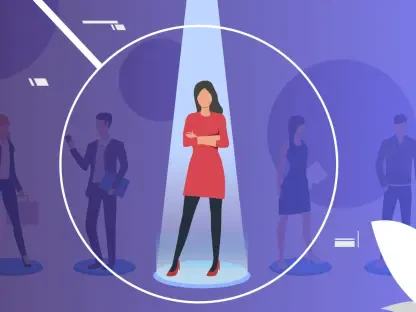In today’s fast-evolving technological landscape, Generative AI (Gen AI) stands as a game-changer, revolutionizing industries by automating routine tasks, enhancing decision-making processes, and sparking unprecedented innovation across sectors. However, the challenge for organizations isn’t merely implementing this cutting-edge technology; it’s ensuring that the workforce is not only prepared but genuinely eager to adopt it. Without authentic employee buy-in, even the most sophisticated Gen AI training initiatives risk falling short, leaving companies unable to harness the full transformative power of AI. Engagement isn’t just a peripheral concern—it’s the bedrock upon which successful adoption is built. When employees are truly invested, they absorb new skills more effectively, apply them in meaningful ways, and contribute to organizational growth. This article delves into the critical role of employee engagement in Gen AI strategies, exploring why it’s indispensable and how innovative approaches can cultivate a committed and capable workforce ready to drive AI-driven progress.
Rethinking Training for a Digital Era
The traditional methods of training, often characterized by lengthy lectures or standardized online modules, frequently fail to ignite interest or foster active participation when it comes to mastering Gen AI tools. These outdated, one-size-fits-all approaches tend to leave employees feeling detached, unable to connect the technology to their everyday responsibilities. As a result, knowledge retention plummets, and organizations squander valuable time and resources on programs that yield minimal impact. The disconnect is particularly stark in a field as dynamic as AI, where practical relevance is key to understanding. Employees subjected to passive learning often struggle to grasp how Gen AI can streamline their workflows or enhance their output, leading to frustration and disengagement. Moreover, the rapid pace of technological change means that static content quickly becomes obsolete, further diminishing the effectiveness of such training. A fundamental shift in approach is necessary to bridge this gap, ensuring that learning resonates with the workforce and equips them for real-world application.
A more effective path lies in embracing interactive, experiential learning tailored to the unique demands of Gen AI adoption. Hands-on workshops, simulations, and role-playing scenarios allow employees to engage directly with AI tools in controlled, practical environments. For instance, customer service teams might test AI-driven chatbots through simulated interactions, gaining both technical proficiency and a clearer sense of how the technology enhances their roles. This “learning by doing” methodology not only sharpens skills but also builds confidence, demystifying complex tools and making them feel accessible. Such approaches prioritize relevance, ensuring that training mirrors the specific challenges employees face in their day-to-day tasks. By seeing immediate applications of Gen AI, workers are more likely to embrace it as a valuable asset rather than an abstract concept. This shift from passive absorption to active participation marks a critical step in securing buy-in, setting the stage for deeper engagement and long-term success in AI integration.
Fueling Motivation with Rewards and Growth
Motivation serves as a cornerstone in achieving employee buy-in for Gen AI initiatives, and strategically designed incentives can significantly boost participation. Offering tangible rewards, such as bonuses, gift cards, or additional vacation days, creates a positive reinforcement loop that encourages employees to complete training programs with enthusiasm. Real-world examples demonstrate the impact of such strategies, with global firms successfully using small but meaningful perks to acknowledge AI skill development. Beyond material benefits, public recognition—whether through company-wide announcements or internal awards—can further inspire individuals by validating their efforts. These gestures signal that the organization values their commitment to learning, fostering a culture where growth is celebrated. When employees feel appreciated for their dedication to mastering Gen AI, they are more inclined to invest time and energy, transforming training from a mandatory task into a rewarding endeavor.
Equally important is the connection between Gen AI training and tangible career advancement opportunities, which adds a layer of personal significance to the learning process. When employees understand that mastering AI skills can lead to promotions, expanded responsibilities, or new roles within the organization, their motivation shifts from mere compliance to genuine ambition. This alignment of individual aspirations with company objectives creates a powerful synergy, encouraging sustained engagement over time. For instance, framing AI proficiency as a pathway to leadership positions or specialized technical roles can inspire workers to view training as an investment in their future. This approach not only drives participation but also helps retain talent in a competitive market where AI expertise is increasingly in demand. By linking learning to long-term professional growth, organizations can cultivate a workforce that sees Gen AI not as a threat or burden, but as a vital tool for personal and corporate success.
Fostering a Shared Journey Through Collaboration
While individual skill-building remains essential for Gen AI adoption, creating a sense of community within the workforce can elevate engagement to new heights. Communities of practice—structured groups where employees exchange insights, tackle challenges together, and celebrate achievements—offer a supportive framework that transforms learning into a collective endeavor. These collaborative spaces encourage open dialogue, allowing participants to share practical tips on using AI tools or brainstorm innovative applications specific to their roles. Such interactions foster a sense of belonging, making employees feel part of a larger mission rather than isolated learners. The resulting camaraderie strengthens their commitment not only to the technology but also to the organization’s broader goals. By prioritizing teamwork, companies can ensure that Gen AI adoption becomes a unified effort, where shared purpose drives both individual growth and collective progress.
Beyond immediate learning benefits, collaborative environments sustain long-term innovation by keeping the conversation around Gen AI alive. Regular meetups, virtual forums, or informal discussion groups provide ongoing opportunities for employees to refine their skills and address evolving challenges as AI technologies advance. These platforms also serve as a safe space to voice concerns or uncertainties about AI, enabling peer-to-peer problem-solving that builds resilience. For example, a marketing team might collaborate to explore how Gen AI can optimize content creation, sharing successes that inspire others to experiment. This continuous exchange of ideas prevents stagnation, ensuring that training isn’t a one-off event but a dynamic process. As employees witness firsthand how their contributions shape outcomes, their investment in Gen AI deepens, reinforcing a culture of innovation. Collaborative learning thus acts as a catalyst, turning individual buy-in into a powerful, organization-wide movement.
Enhancing Learning with AI-Driven Solutions
Innovative use of Gen AI itself within training programs offers a compelling way to boost employee engagement and effectiveness. Adaptive learning platforms, powered by AI, customize content to match each individual’s skill level, learning pace, and specific needs, ensuring that no one feels overwhelmed or left behind. For instance, a beginner might receive foundational tutorials on AI concepts, while a more advanced learner tackles complex applications relevant to their role. This personalization keeps training relevant and engaging, as employees encounter material that directly addresses their gaps or interests. By dynamically adjusting to feedback and progress, these platforms maintain momentum, preventing the frustration often associated with generic courses. The result is a more confident workforce, equipped to apply Gen AI in ways that are both practical and impactful for their unique responsibilities.
Moreover, AI-driven simulations and virtual scenarios provide immersive experiences that mirror real-world challenges, further enhancing the learning process. Employees can test Gen AI tools in safe, controlled settings—such as supply chain managers optimizing logistics with predictive algorithms—gaining hands-on expertise without the risk of costly errors. These interactive elements not only build technical know-how but also demonstrate the tangible benefits of AI, making abstract concepts concrete. Gamification features, like earning points or badges for completing modules, can be integrated to add an element of friendly competition, further driving participation. Such approaches ensure that training feels less like a chore and more like a meaningful journey of discovery. By leveraging Gen AI to tailor and enrich the learning experience, organizations can address diverse needs within their workforce, fostering a deeper sense of buy-in and preparing employees for seamless integration of AI into their daily workflows.
Addressing Doubts with Transparency and Inspiration
A significant barrier to employee buy-in for Gen AI often stems from skepticism or fear, particularly the concern that AI might replace human roles rather than complement them. Addressing these apprehensions head-on is crucial for fostering trust and engagement. Leadership must prioritize transparent communication, clearly articulating how Gen AI is intended to enhance productivity, creativity, and job security rather than diminish them. Detailed explanations of how AI will streamline repetitive tasks, allowing employees to focus on higher-value work, can help alleviate fears. Regular updates on the organization’s AI strategy, coupled with opportunities for staff to ask questions or express concerns, create, create an open dialogue that builds confidence. When employees understand the purpose behind Gen AI adoption and see their input valued, resistance diminishes, paving the way for genuine enthusiasm and a willingness to embrace new tools.
Complementing transparency with inspiration can further shift mindsets and encourage buy-in across the workforce. Sharing success stories—whether from within the company or from industry peers—illustrates the real-world advantages of Gen AI, making its benefits tangible and relatable. For example, highlighting how a sales team used AI to predict customer trends and boost revenue can motivate others to explore similar applications. Internal case studies, testimonials, or even live demonstrations of AI in action provide concrete evidence that the technology is a partner, not a threat. These narratives help employees visualize how mastering Gen AI can directly impact their performance and career trajectory. By combining clear, honest communication with compelling examples, organizations can transform doubt into curiosity, encouraging a proactive attitude toward training and ensuring that employees feel empowered to navigate the evolving landscape of AI with optimism.
Tangible Results from Prioritizing Engagement
The transformative power of employee buy-in becomes strikingly evident through real-world examples of organizations that have prioritized engagement in their Gen AI strategies. A mid-sized logistics firm offers a compelling case study, having initially faced dismal participation in its AI training programs due to lack of interest and relevance. By revamping their approach with role-specific workshops tailored to daily tasks, gamified modules offering rewards like paid leave, and discussion groups for peer support, the company witnessed a remarkable turnaround. Within just six months, training completion rates surged by 65%, reflecting a newfound enthusiasm among employees. Even more impressively, supply chain efficiency improved by over 20%, directly attributable to the practical application of AI skills learned through engaging methods. This example underscores how focusing on buy-in can yield measurable gains, not just in learning outcomes but in core business performance.
Beyond isolated success, such results highlight a broader truth about the link between engagement and operational impact in Gen AI adoption. When employees are motivated to learn and apply AI tools, the benefits ripple across departments, driving innovation and efficiency at scale. In the logistics firm’s case, workers who once viewed training as a burden began proactively suggesting AI-driven solutions for longstanding bottlenecks, further amplifying improvements. This shift from passive participation to active contribution illustrates the untapped potential within an engaged workforce. Organizations that invest in dynamic, employee-centered training approaches not only close skill gaps but also cultivate a culture of continuous improvement. The evidence is clear: prioritizing buy-in isn’t merely a strategy for better learning—it’s a catalyst for transforming how businesses operate, compete, and thrive in an AI-powered era, delivering outcomes that resonate far beyond the classroom.
Paving the Way for Sustainable AI Integration
Reflecting on the journey of Gen AI adoption, it’s evident that employee buy-in stands as the linchpin of successful implementation for many organizations. Companies that tackled disengagement head-on with interactive training, meaningful incentives, collaborative environments, and personalized learning tools saw their workforces transform from hesitant to empowered. These efforts paid off in higher skill retention, innovative applications of AI, and measurable business gains, as demonstrated by real-world turnarounds in industries like logistics. Looking ahead, the focus should shift to sustaining this momentum by embedding engagement into long-term strategies. Regularly updating training content to reflect AI advancements, expanding communities of practice for ongoing collaboration, and continuously showcasing success stories can keep enthusiasm alive. Additionally, organizations might consider integrating feedback mechanisms to refine learning experiences, ensuring they remain relevant and inspiring. By committing to these steps, businesses can build a resilient, AI-ready workforce poised to navigate future challenges with confidence and creativity.









